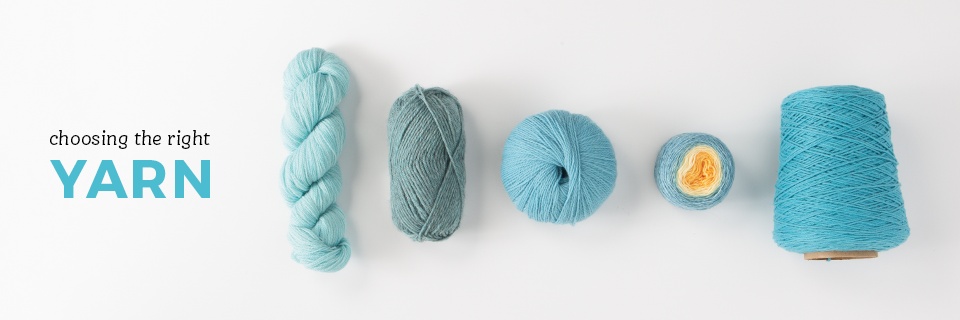
Choosing the right yarn for a project can make the difference as to whether you love or loathe working on a crochet project. Let’s talk about all the things to keep in mind when choosing the best yarn for crochet!
If you haven’t tried crocheting with many different fibers, you might not be sure how to choose yarn for crochet. Did you know that the yarn you choose affects how much you enjoy your crochet project and how well the final product turns out? The fiber in the yarn helps determine if the project will be washable, be delicate or sturdy, shiny or matte, and many other factors. There is no bad fiber, but there are better fiber choices depending on what you want your final project to be.
It takes time and experience to learn exactly how each yarn will affect your work. As you use more types of yarn, you will gain knowledge about how yarn fibers affect your crochet projects. But if you aren’t there yet, don’t worry! We will walk you through everything you need to know about selecting the right yarn for your crochet project.
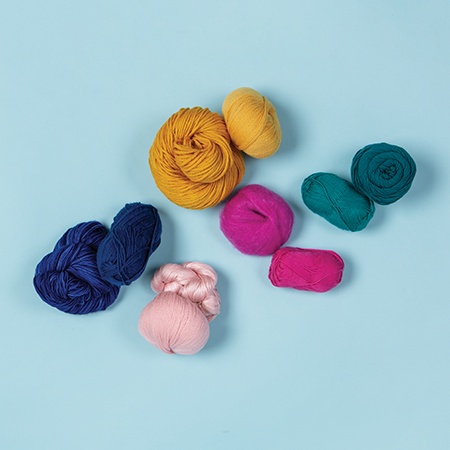
First we’ll talk about yarn weight and learn about the differences between each weight and how they can affect your project. Next, we’ll go over the fiber content of yarn: we’ll talk about many different fibers (like cotton, wool, acrylic, and silk) and how to choose fibers that will complement your crochet. We’ll also talk about practical considerations and things to remember when buying yarn. Finally, we’ll share some tips for successful yarn color selection.
Let’s find your perfect yarn! Will it be a skein of acrylic yarn, a hank of cotton yarn, some super soft yarn, or a new fiber you’ve never tried?
Yarn Weight
The first thing to consider when choosing the ideal yarn for your crochet project is what weight of yarn you will use. The weight of the yarn refers to the thickness of the strand of yarn, and how many times it can be wrapped around a 1 inch section of a ruler (wraps per inch). Yarn labels always list the weight of the yarn to help you match it to your pattern. The yarn weight combined with the crochet hook size you use will affect the project’s drape.
When you decide to crochet a project, the pattern will typically list the weight of yarn. If you use a large yarn for a pattern written for a smaller yarn, your project will end up much larger than expected and it might be hard to use or wear. For best results, follow the suggested yarn weight when making a crochet pattern and be sure to check your crochet gauge.
Yarn Weight Terminology
Across the crochet community, there are some differences in yarn weight terminology. The Craft Yarn Council has put forward a standard system for yarn weights that many yarn companies and crochet designers have adopted. This standardization is based on a number system that corresponds to a common descriptive term that is used to describe a yarn weight; the higher the number, the thicker the yarn. These terms apply whether you are a crocheter or a knitter!
Here is a handy chart to help you visualize various yarn weights.
Yarn Weight Standards Chart
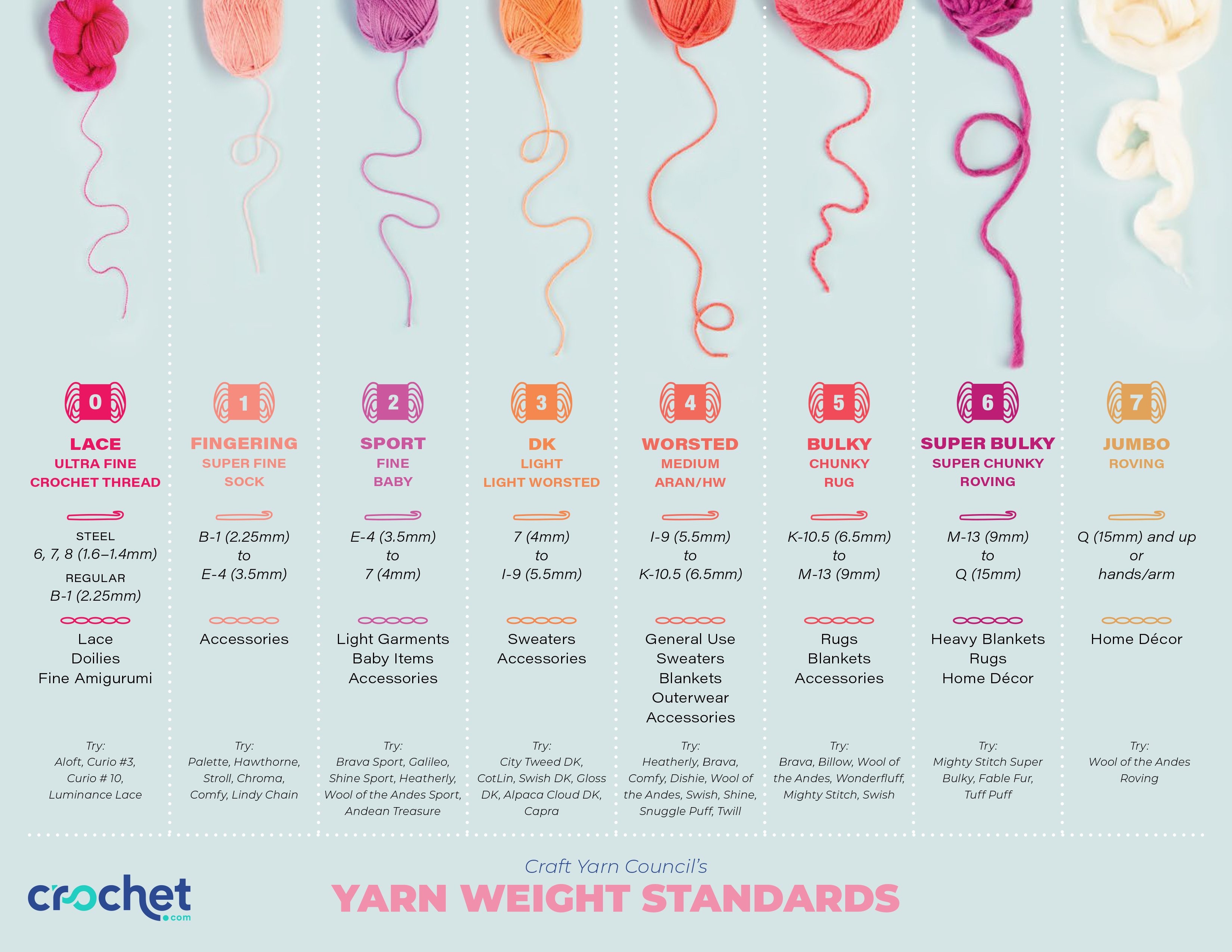
Yarn comes in a variety of weights, starting from the number 0 (smallest) and ranging through number 7 (bulkiest):
0 Lace Weight (which is very thin and fine): 16+ wraps per inch
1 Fingering Weight (which is slightly thicker): 14-16 wraps per inch
2 Sport Weight: 12 wraps per inch
3 DK Weight, Light Worsted Weight: 10-11 wraps per inch
4 Worsted, Aran/Heavy Worsted: 8-9 wraps per inch
5 Bulky: 7 wraps per inch
6 Super-Bulky: 5-6 wraps per inch
7 Jumbo (very large, like wool roving): 4 or fewer wraps per inch
Yarn Weight Identification Tip:
If you are unsure of a yarn’s weight, for instance if you have yarn that lost its label, you can still determine the yarn’s weight by using a yarn gauge tool. This small tool has a 1 inch groove in it that you can wrap the yarn around, along with a legend telling you how many wraps per inch for each yarn weight. Wrap your unidentified yarn around the tool, and count the wraps to identify the yarn’s weight.
You can also achieve this same effect by using a standard ruler and carefully wrapping the yarn around a one inch section and then counting the wraps per inch.
Now let’s talk more about each yarn weight and our favorite yarns in each weight.
Yarn Size 0: Lace Weight
Lace weight is extremely fine in thickness, which helps it create the delicate openwork textures of lace crochet. Lace weight yarn is often used to crochet shawls, lightweight garments, and accessories. You can also hold lace weight yarn double and crochet with two strands to make it more substantial. Lace weight yarn can be made of silk, mohair, wool, cotton, alpaca, or other fibers.
Yarn Size 0: Crochet Thread
Crochet thread is also classified as lace weight yarn, but it has different properties than other lace yarns, due to its high twist. Crochet thread is used for making projects like doilies, lace trims, home decor items, shawls, and even garments.
Crochet thread comes in different thicknesses and is sized by a number that gets larger as the yarn gets finer. For example, #3 crochet thread is the thickest (and similar to fingering weight yarn), and #10 thread is smaller (and similar to lace weight yarn). If you do really intricate lace work, you might even encounter #20 or #60 thread, which is sometimes challenging to work with because of its thinness.
The Best Crochet Thread
Curio #10: This mercerized, 2-ply #10 crochet thread is available in a brilliant range of shades and provides crisp stitch definition that highlights intricate stitches and textures with a lustrous sheen. We love it for crocheted home décor items such as doilies, coasters, table cloth, curtains, as well as garments and accessories like tops and shawls, thanks to its fashion-forward color palette.
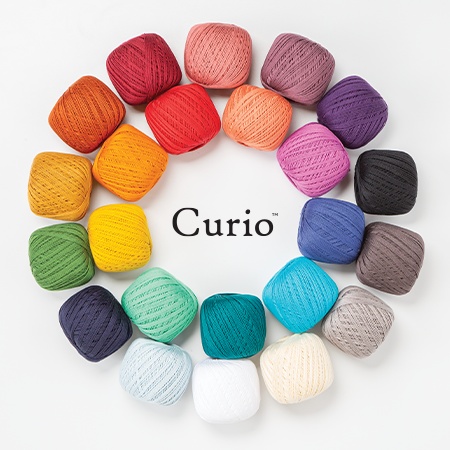
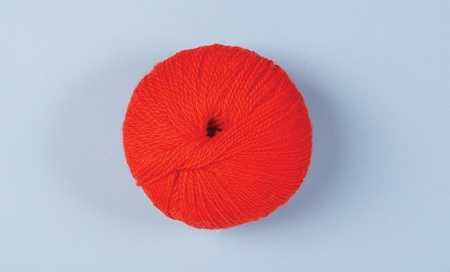
Yarn Size 1: Fingering Weight
Fingering weight yarn (also known as super fine, sock, or baby yarn) is a good choice for crocheting garments and accessories, because it’s light enough to allow great drape and warmth. Fingering weight yarn is commonly used for colorwork, socks, accessories, and sweaters. Fingering weight yarn can be made of wool, cotton, alpaca, or other fibers, and is often combined with nylon or silk to add strength (especially useful for hard-wearing items like socks).

Yarn Size 2: Sport Weight
Sport weight yarn (also known as fine or baby yarn) is commonly used for baby garments and baby blankets because it’s lighter than worsted and makes lighter weight items. Of course, sport weight yarns can be used for other crochet projects as well, such as crochet afghans, garments for any size person, accessories, or crocheted toys (amigurumi). Sport weight yarn can be made in many different fibers, such as wool, acrylic, cotton, alpaca, or bamboo.
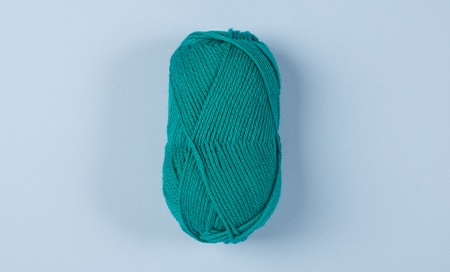
Yarn Size 3: DK and Light Worsted Weight
DK and Light Worsted weight yarns are lumped together in the Craft Yarn Council’s yarn weight standardization, but they are not quite the same! They are sometimes also known as light weight yarns.
DK yarn (named from the older term “double knitting”) is roughly the weight of two strands of fingering weight yarn held together. It’s lighter than worsted weight, and DK yarn is often used for making garments because it’s not quite as bulky as worsted weight, and the fabric can have a bit more drape. DK is available in fibers such as Merino wool, baby alpaca, cotton, linen, and cashmere.
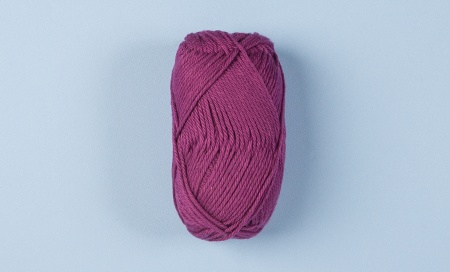
Yarn Size 4: Worsted Weight and Aran/Heavy Worsted
Worsted weight yarn is one of the most popular yarn weights for crocheters, and is usually the first yarn you encounter (especially if you live in the USA). In other countries, worsted weight is sometimes called 4-ply or medium weight. Basically an all-purpose yarn, worsted can be used to make garments, accessories, blankets, toys, home decor items, dishcloths and more. You will find worsted weight yarns available in every fiber type, from acrylic to wool to cotton to more exotic fibers like alpaca, silk, or Donegal tweed.
Aran weight yarns are also known as heavy worsted (or sometimes afghan yarn), so sometimes we refer to them with a slash and say “Aran/HW.” Aran yarns are slightly heavier than worsted weight.
You can use Aran/HW yarn for many patterns, such as sweaters, home decor items, and accessories, and sometimes Aran weight yarn can be used in place of worsted weight patterns, depending on your crochet gauge. Aran/HW weight yarns can be made from a variety of fibers, such as superwash Merino wool, cotton, alpaca, and more.
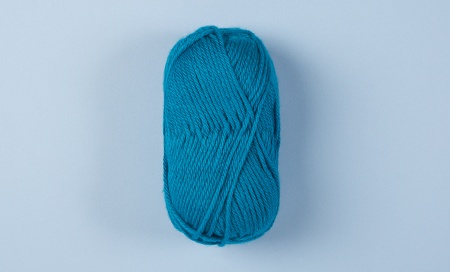
Yarn Size 5: Bulky Weight
Bulky weight yarns (also known as chunky, craft, or rug yarns) are bigger than worsted weight, and are great because they work up very quickly. Often used for home decor projects like rugs and baskets, bulky weight yarns are also excellent for making warm sweaters, accessories, or cozy blankets. Bulky yarns come in a variety of fibers such as acrylic, wool, alpaca, or cotton.
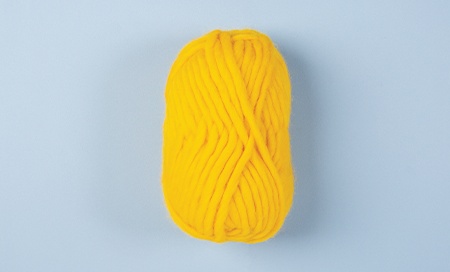
Yarn Size 6: Super-Bulky Weight
Super-Bulky yarns are very thick and often used for crafts, crochet blankets, home decor projects, or other special situations where a very large yarn is needed. Because of their thickness, projects made in super-bulky yarns are very fast, and you can sometimes complete an entire project in an evening. You’ll find super-bulky yarns made in a variety of fibers such as wool, acrylic, polyester, or alpaca.
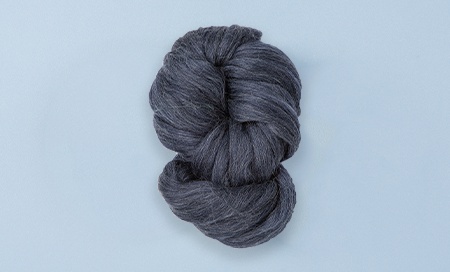
Yarn Size 7: Jumbo Weight
Jumbo is a relatively new weight description from the Craft Yarn Council, and was created specifically because of the popularity of arm-knitting and crochet. These yarns are so big they really can’t be wrapped around a yarn weight gauge! Jumbo yarns are usually used for home decor like very bulky blankets, felting projects, or wall art. While jumbo yarns are less common, you can find them made from fibers like wool roving, polyester chenille, cotton t-shirt style yarn, or other assorted fibers.
Whew. Now you know so much about yarn weight! Let’s talk about the next thing to consider when you’re choosing the best yarn for crochet projects: fiber!
Yarn Fiber Content
The next thing to consider when picking the perfect crochet yarn is fiber content, or what the yarn is made of. Yarn can be made of many things from natural (animal or plant fibers) to manufactured (acrylic, nylon, and more), to novelty fibers (like metallic fibers or recycled fabric), and even experimental fibers (such as fiber made from milk or kelp).
The fiber content of the yarn you select has a tremendous impact on how your project will look and feel. Fiber content affects the drape (how the fabric moves), the stitch definition (important to consider when using an intricate stitch or cables), the structure, and the heaviness of the final product.
Natural vs Synthetic Yarns
Yarns are made from a variety of sources. Let’s examine the differences between natural yarns, synthetic yarns, and fiber blends.
Natural Yarns
Natural yarns come from animal fur (or silk) or plants that are harvested safely and do not contain any synthetic materials. Natural fibers include animal fibers like alpaca, cashmere, Merino wool, mohair, silk, and wool. Plant-based natural fibers include bamboo, beechwood fiber, cotton, and linen.
While natural fibers are sourced from nature, they are still often put through manufacturing processes to prepare them to spin into yarn. For instance, bamboo and beechwood are treated either chemically or mechanically to break the fiber down and prepare it for spinning. Superwash yarns are also treated with conditioners, enzymes, or chemicals to help smooth the edges of the fiber.
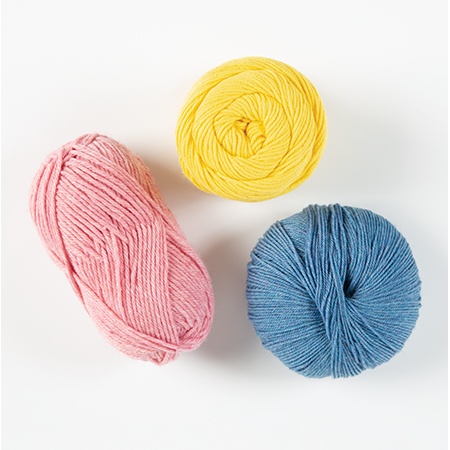
Some other natural fibers go through rigorous tests to ensure they are environmentally-friendly. Oeko-Tex yarns are produced without any harmful chemicals or substances and certified to be gentler on human bodies and the environment. Some wool yarns are produced under the Responsible Wool Standard (RWS), which is an initiative that ensures animal welfare, land health, and has standards that are upheld from farm to retailer. Some natural fibers are turned into yarn without any additional dyes or coloring, preserving the fiber’s original color.
Although it might appear that natural fibers are more expensive, they have many features and benefits that make them well worth the investment. Animal fibers such as wool and alpaca will often last a lifetime, while plant fibers are breathable and comfy for warm weather wear. In addition, natural fibers are sourced from renewable resources that grow year after year.
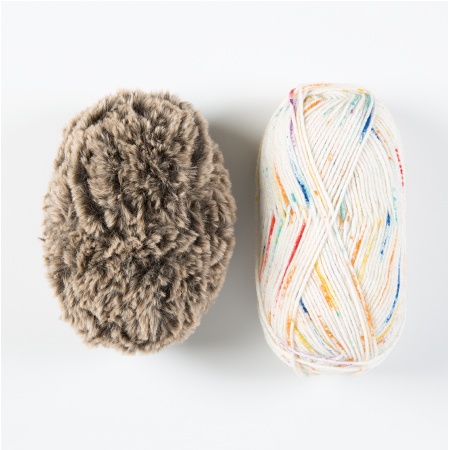
Synthetic Yarns
Synthetic yarns are manufactured from a variety of materials including polymers, coal, or petroleum and turned into filaments that can then be spun and twisted into yarn. Some natural fibers are subject to a similar process and are therefore derived from a natural source but synthetically made into yarn. Synthetic fibers include acrylic, elastic, modal (a beechwood product), nylon, rayon (made from wood cellulose), and viscose (a bamboo product).
Synthetic yarn is often inexpensive and a good choice for beginner fiber artists, as it is easy to find and available in nearly every weight and color. In addition, many synthetic yarns are easy-care, machine-washable, and hypo-allergenic. Synthetic yarns are also an option for people who have allergies to animal fibers, or who would prefer not to use animal products.
Yarn Blends
Many of our favorite yarns are blends! Yarn blends combine different types of fiber to create a new yarn that takes the best qualities from all the blended fibers and combines them into a fantastic new skein of yarn.
Some blends are made to improve the characteristics of a yarn. For instance, in sock yarns you will often find a percentage of nylon or silk, which adds strength to wool and helps the fiber last much longer in a heavy-wear sock. Other fibers like bamboo or silk add shine to a yarn, while combining a plant fiber with an animal fiber can help keep the yarn from being too warm.
Other blends are made for aesthetic reasons. For instance, tweed yarns are made by suspending Donegal tweed in a fine nylon mesh and then spinning it with other fibers to create the flecks of a traditional tweed yarn.
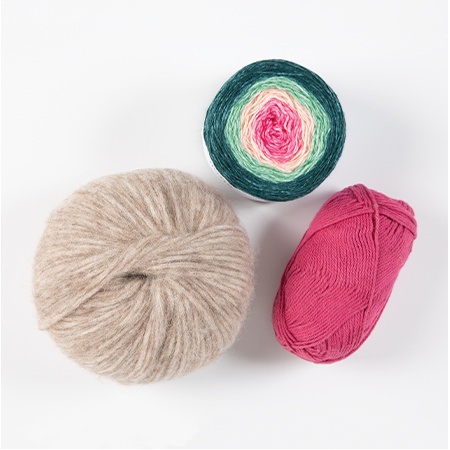
Things To Remember When Purchasing Yarn
When purchasing yarn for a single project, keep these things in mind:
Dye Lot: Yarn in the same dye lot will have the same color; when making a large project, buy yarn from the same dye lot so yarn will blend together with no variation in color.
Care Instructions: Consider how the yarn should be washed. When using multiple fiber types in one project, it’s best to follow the instructions for the most delicate yarn.
Yardage: Pay attention to the yardage listing on the skein’s label. This helps to determine how many balls of yarn are needed for your project. To calculate how many balls of yarn you’ll need, take the total yardage listed in your pattern and divide by the yardage listed on one ball. Round up to the highest number to figure out how many balls you’ll need for your project.
Buy Extra: Even when you are careful with your yarn calculations, it’s best practice to buy an extra ball of yarn or two for your project, to ensure you can finish without interruption.
Yarn Color
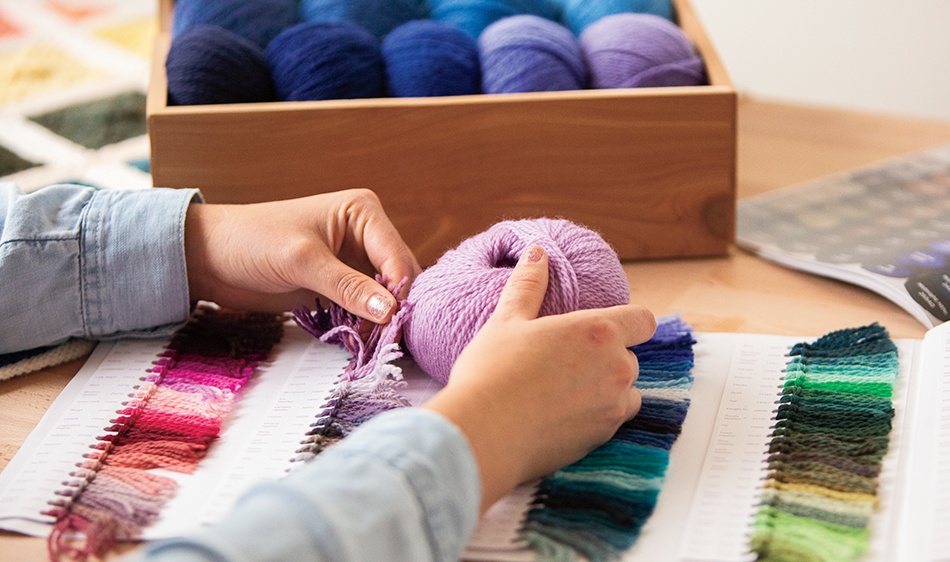
We saved the most fun part about choosing yarn for last: COLOR! Color selection is a personal decision, and we could write a book on how to choose a color for your project. Your crochet project color choice depends on your own unique style, but with the wide variety of colors at WeCrochet, we know you'll find the perfect shade of yarn for your next crochet project!
As you can see, a lot of factors go into deciding which yarn to use for your crochet projects. The best way to figure it out is to start crocheting. When you experiment with more yarns, fibers, and colors, you will start to learn what you prefer. Happy yarn shopping!






